
How to solve: Java graphical interface error: Image loading failure
Introduction:
During the development process of Java graphical interface, image loading failure is often encountered. Condition. Images are common elements in interface design, so when images fail to load, it will seriously affect the user experience. This article will introduce some common reasons for image loading failure, and provide corresponding solutions and code samples.
1. File path error
In Java, the loading path of image files is relative to the class path. If the file path is incorrect, the Java virtual machine cannot correctly find the image file to be loaded, causing the loading to fail. Therefore, handling file paths correctly is the first step in resolving image loading failures.
Solution 1: Use absolute path
You can use an absolute path to specify the location of the image file to be loaded. For example, if the image file is located in the img folder of the D drive, you can use the following code to load the image:
String imagePath = "D:/img/image.jpg"; ImageIcon imageIcon = new ImageIcon(imagePath);
Solution 2: Use relative paths
Relative paths refer to paths relative to the classpath. You can use the following code to get the class path of the current class and use the relative path to load the image file:
String imagePath = getClass().getResource("/image.jpg").getPath();
ImageIcon imageIcon = new ImageIcon(imagePath); 2. File encoding issue
If the encoding method of the loaded image file is incompatible with the Java virtual machine, also Will cause image loading to fail. When dealing with image loading issues, you need to ensure that the encoding of the image file is consistent with the encoding of the Java virtual machine.
Solution:
You can use the specified encoding method to load the image file, for example:
String imagePath = "path/to/image.jpg"; InputStream inputStream = new FileInputStream(imagePath); BufferedImage bufferedImage = ImageIO.read(inputStream);
3. Image file damage
If the loaded image file itself is damaged or the format is incorrect Correct, will also cause image loading to fail. In this case, you need to check whether the image file can be opened normally and ensure that the format of the image file is a format supported by Java (such as JPEG, PNG, etc.).
Solution:
You can try to open the image file and make sure it can be displayed normally. If the image file is corrupted or incorrectly formatted, the correct image file can be downloaded and replaced with the correct file.
4. Image loading method error
Java provides a variety of methods for loading images, such as ImageIcon, ImageIO, etc. Image loading can also fail if the incorrect loading method is used.
Solution:
You can try to use other methods of loading images, such as using ImageIO to load image files:
String imagePath = "path/to/image.jpg"; BufferedImage bufferedImage = ImageIO.read(new File(imagePath));
Conclusion:
By correctly processing the file path and encoding method , checking whether the image file is damaged and selecting the correct image loading method can solve the problem of image loading failure in the Java graphical interface. In actual development, we should pay attention to capturing and handling image loading exceptions to improve user experience and program stability. I hope this article can help solve the problem of image loading failure in Java graphical interface.
Reference materials:
- Java official documentation: https://docs.oracle.com/en/java/javase/
- Java image loading and display: https://www.jianshu.com/p/fb65da5779b7
The above is the detailed content of How to fix: Java GUI Error: Image load failed. For more information, please follow other related articles on the PHP Chinese website!
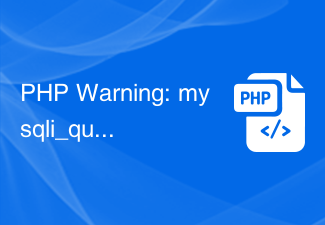 PHP Warning: mysqli_query(): Empty query的解决方法Jun 22, 2023 pm 04:45 PM
PHP Warning: mysqli_query(): Empty query的解决方法Jun 22, 2023 pm 04:45 PM在使用PHP开发Web应用时,经常会遇到各种各样的问题。其中,一些常见的问题是与MySQL数据库相关的问题。有一种问题是“PHPWarning:mysqli_query():Emptyquery”的错误。本文将介绍此错误的原因以及解决方法。首先,让我们看看这个错误表示什么。当您使用mysqli_query函数执行MySQL查询时,如果该查询为空,则会
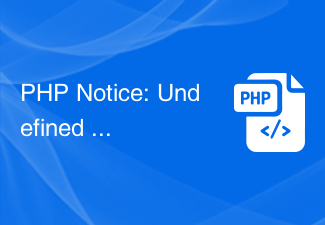 PHP Notice: Undefined property: stdClass::$的解决方法Jun 22, 2023 pm 10:24 PM
PHP Notice: Undefined property: stdClass::$的解决方法Jun 22, 2023 pm 10:24 PM在使用PHP编写代码时,我们经常会看到这样的错误提示:“PHPNotice:Undefinedproperty:stdClass::$”。这个错误提示通常是由于在使用对象的属性时,该属性不存在而引起的。在本文中,我们将讨论如何解决这个问题。首先,我们需要了解这个错误提示的原因。当我们使用对象的属性时,PHP会首先检查该属性是否存在。如果该属性不存在,
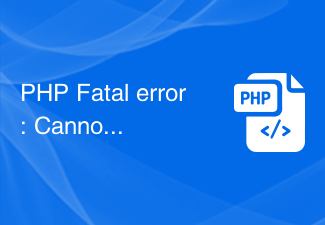 PHP Fatal error: Cannot redeclare的解决方法Jun 22, 2023 pm 07:43 PM
PHP Fatal error: Cannot redeclare的解决方法Jun 22, 2023 pm 07:43 PM在使用PHP进行开发的过程中,有时候会遇到“PHPFatalerror:Cannotredeclare”错误,这个错误通常会出现在如下情况:在PHP代码中多次include/require同一个文件。在代码中定义了和已有的函数/类重名的函数/类。这个错误会导致程序无法继续执行,为了解决这个问题,我们需要了解其产生原因和解决方法。产生原
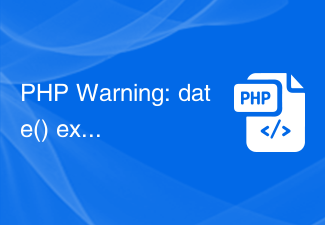 PHP Warning: date() expects parameter 2 to be long, string given的解决方法Jun 22, 2023 pm 08:03 PM
PHP Warning: date() expects parameter 2 to be long, string given的解决方法Jun 22, 2023 pm 08:03 PM在使用PHP程序开发时,经常会碰到一些警告或者错误的提示信息。其中,可能出现的一个错误提示就是:PHPWarning:date()expectsparameter2tobelong,stringgiven。这个错误的提示信息意思是:函数date()的第二个参数期望是长整型(long),但是实际传递给它的是字符串(string)。那么,我们
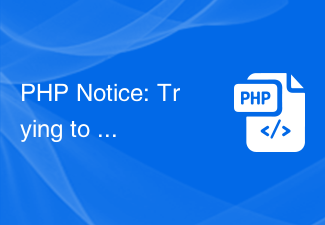 PHP Notice: Trying to get property ‘的解决方法’ of non-object的解决方法Jun 22, 2023 am 11:51 AM
PHP Notice: Trying to get property ‘的解决方法’ of non-object的解决方法Jun 22, 2023 am 11:51 AM当我们在使用PHP进行开发时,有时会遇到”Tryingtogetproperty‘的解决方法’ofnon-object”的错误提示。这个错误的原因一般是因为程序中对一个不存在或者未实例化的对象进行访问,导致了PHP解析器无法识别该对象的属性或方法。那么,如何解决这个错误呢?下面我将为大家介绍几种可能的解决方法。一、检查代码首先,我们需要将出错的代
 TranslucentTB不起作用:如何解决Jun 06, 2023 am 08:21 AM
TranslucentTB不起作用:如何解决Jun 06, 2023 am 08:21 AMTranslucentTB是寻求时尚简约桌面外观的Windows11爱好者广泛使用的工具,遇到了障碍。自从发布以来Windows11内部版本22621.1344(22H2)28年2023月日,TranslucentTB对大多数用户不起作用。此错误使用户努力应对其任务栏的有限自定义选项。用户在寻求克服这一挫折的解决方案时,挫败感显而易见。在最近的Windows11更新之后,TranslucentTB无法正常工作的问题已在多个在线平台上广泛报道,包括论坛和社交媒体。用户一直在分享他们的经验,拼命寻找
 PHP Notice: Undefined index:的解决方法Jun 22, 2023 am 10:15 AM
PHP Notice: Undefined index:的解决方法Jun 22, 2023 am 10:15 AM当使用PHP开发Web应用程序时,经常会遇到“PHPNotice:Undefinedindex:”这样的错误消息。此错误消息通常与数组相关。在PHP中,当我们使用未定义的数组索引时,就会收到这种类型的错误消息。这通常会发生在以下情况下:尝试访问不存在的数组元素尝试使用错误的键来访问数组在本文中,我们将探讨如何解决此错误,并提供一些常见的应用程序开发实践
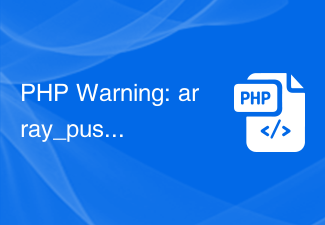 PHP Warning: array_push() expects parameter 1 to be array的解决方法Jun 22, 2023 pm 07:17 PM
PHP Warning: array_push() expects parameter 1 to be array的解决方法Jun 22, 2023 pm 07:17 PMPHPWarning:array_push()expectsparameter1tobearray的解决方法在PHP开发中,我们常常会遇到“TheWarning:array_push()expectsparameter1tobearray”错误。这个错误通常表示我们使用了一个不是数组的变量作为array_push的第一个参数。


Hot AI Tools

Undresser.AI Undress
AI-powered app for creating realistic nude photos

AI Clothes Remover
Online AI tool for removing clothes from photos.

Undress AI Tool
Undress images for free

Clothoff.io
AI clothes remover

AI Hentai Generator
Generate AI Hentai for free.

Hot Article

Hot Tools

WebStorm Mac version
Useful JavaScript development tools

mPDF
mPDF is a PHP library that can generate PDF files from UTF-8 encoded HTML. The original author, Ian Back, wrote mPDF to output PDF files "on the fly" from his website and handle different languages. It is slower than original scripts like HTML2FPDF and produces larger files when using Unicode fonts, but supports CSS styles etc. and has a lot of enhancements. Supports almost all languages, including RTL (Arabic and Hebrew) and CJK (Chinese, Japanese and Korean). Supports nested block-level elements (such as P, DIV),

Dreamweaver CS6
Visual web development tools

PhpStorm Mac version
The latest (2018.2.1) professional PHP integrated development tool

MinGW - Minimalist GNU for Windows
This project is in the process of being migrated to osdn.net/projects/mingw, you can continue to follow us there. MinGW: A native Windows port of the GNU Compiler Collection (GCC), freely distributable import libraries and header files for building native Windows applications; includes extensions to the MSVC runtime to support C99 functionality. All MinGW software can run on 64-bit Windows platforms.





